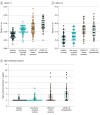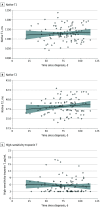Outcomes of Cardiovascular Magnetic Resonance Imaging in Patients Recently Recovered From Coronavirus Disease 2019 (COVID-19)
- PMID: 32730619
- PMCID: PMC7385689
- DOI: 10.1001/jamacardio.2020.3557
Outcomes of Cardiovascular Magnetic Resonance Imaging in Patients Recently Recovered From Coronavirus Disease 2019 (COVID-19)
Erratum in
-
Errors in Statistical Numbers and Data.JAMA Cardiol. 2020 Nov 1;5(11):1308. doi: 10.1001/jamacardio.2020.4648. JAMA Cardiol. 2020. PMID: 32840563 Free PMC article. No abstract available.
Abstract
Importance: Coronavirus disease 2019 (COVID-19) continues to cause considerable morbidity and mortality worldwide. Case reports of hospitalized patients suggest that COVID-19 prominently affects the cardiovascular system, but the overall impact remains unknown.
Objective: To evaluate the presence of myocardial injury in unselected patients recently recovered from COVID-19 illness.
Design, setting, and participants: In this prospective observational cohort study, 100 patients recently recovered from COVID-19 illness were identified from the University Hospital Frankfurt COVID-19 Registry between April and June 2020.
Exposure: Recent recovery from severe acute respiratory syndrome coronavirus 2 infection, as determined by reverse transcription-polymerase chain reaction on swab test of the upper respiratory tract.
Main outcomes and measures: Demographic characteristics, cardiac blood markers, and cardiovascular magnetic resonance (CMR) imaging were obtained. Comparisons were made with age-matched and sex-matched control groups of healthy volunteers (n = 50) and risk factor-matched patients (n = 57).
Results: Of the 100 included patients, 53 (53%) were male, and the mean (SD) age was 49 (14) years. The median (IQR) time interval between COVID-19 diagnosis and CMR was 71 (64-92) days. Of the 100 patients recently recovered from COVID-19, 67 (67%) recovered at home, while 33 (33%) required hospitalization. At the time of CMR, high-sensitivity troponin T (hsTnT) was detectable (greater than 3 pg/mL) in 71 patients recently recovered from COVID-19 (71%) and significantly elevated (greater than 13.9 pg/mL) in 5 patients (5%). Compared with healthy controls and risk factor-matched controls, patients recently recovered from COVID-19 had lower left ventricular ejection fraction, higher left ventricle volumes, and raised native T1 and T2. A total of 78 patients recently recovered from COVID-19 (78%) had abnormal CMR findings, including raised myocardial native T1 (n = 73), raised myocardial native T2 (n = 60), myocardial late gadolinium enhancement (n = 32), or pericardial enhancement (n = 22). There was a small but significant difference between patients who recovered at home vs in the hospital for native T1 mapping (median [IQR], 1119 [1092-1150] ms vs 1141 [1121-1175] ms; P = .008) and hsTnT (4.2 [3.0-5.9] pg/dL vs 6.3 [3.4-7.9] pg/dL; P = .002) but not for native T2 mapping. None of these measures were correlated with time from COVID-19 diagnosis (native T1: r = 0.07; P = .47; native T2: r = 0.14; P = .15; hsTnT: r = -0.07; P = .50). High-sensitivity troponin T was significantly correlated with native T1 mapping (r = 0.33; P < .001) and native T2 mapping (r = 0.18; P = .01). Endomyocardial biopsy in patients with severe findings revealed active lymphocytic inflammation. Native T1 and T2 were the measures with the best discriminatory ability to detect COVID-19-related myocardial pathology.
Conclusions and relevance: In this study of a cohort of German patients recently recovered from COVID-19 infection, CMR revealed cardiac involvement in 78 patients (78%) and ongoing myocardial inflammation in 60 patients (60%), independent of preexisting conditions, severity and overall course of the acute illness, and time from the original diagnosis. These findings indicate the need for ongoing investigation of the long-term cardiovascular consequences of COVID-19.
Conflict of interest statement
Figures



Comment in
-
Coronavirus Disease 2019 (COVID-19) and the Heart-Is Heart Failure the Next Chapter?JAMA Cardiol. 2020 Nov 1;5(11):1216-1217. doi: 10.1001/jamacardio.2020.3575. JAMA Cardiol. 2020. PMID: 32730614 No abstract available.
-
Errors in Statistical Numbers and Data in Study of Cardiovascular Magnetic Resonance Imaging in Patients Recently Recovered From COVID-19.JAMA Cardiol. 2020 Nov 1;5(11):1307-1308. doi: 10.1001/jamacardio.2020.4661. JAMA Cardiol. 2020. PMID: 32840561 No abstract available.
-
Explanation for the Corrections for the Study of Cardiovascular Magnetic Resonance Imaging in Patients Recently Recovered From Coronavirus Disease 2019.JAMA Cardiol. 2020 Nov 1;5(11):1308. doi: 10.1001/jamacardio.2020.4667. JAMA Cardiol. 2020. PMID: 32840577 No abstract available.
-
Cardiac Involvement After Recovering From COVID-19.JAMA Cardiol. 2021 Feb 1;6(2):243. doi: 10.1001/jamacardio.2020.5276. JAMA Cardiol. 2021. PMID: 33112368 No abstract available.
-
Cardiac Involvement After Recovering From COVID-19.JAMA Cardiol. 2021 Feb 1;6(2):243-244. doi: 10.1001/jamacardio.2020.5279. JAMA Cardiol. 2021. PMID: 33112937 No abstract available.
-
Beyond the AJR: "Outcomes of Cardiovascular Magnetic Resonance Imaging in Patients Recently Recovered From Coronavirus Disease 2019 (COVID-19)".AJR Am J Roentgenol. 2021 Jul;217(1):260. doi: 10.2214/AJR.20.25140. Epub 2020 Dec 23. AJR Am J Roentgenol. 2021. PMID: 33355486 No abstract available.
-
Cardiac involvement in athletes recently recovered from COVID-19.Hellenic J Cardiol. 2022 Nov-Dec;68:63-65. doi: 10.1016/j.hjc.2022.09.012. Epub 2022 Sep 28. Hellenic J Cardiol. 2022. PMID: 36181997 Free PMC article. No abstract available.
References
Publication types
MeSH terms
Substances
LinkOut - more resources
Full Text Sources
Other Literature Sources
Medical
Miscellaneous

